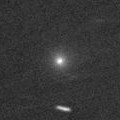
|
New bright comet. Now it is 9.4 mag (July 26, Michael Jager). It locates extremely low in the northern sky in the Northern Hemisphere. It is not observable in the Southern Hemisphere. It will be unobservable soon also in the Northern Hemisphere. Then it will not be observable until December when it becomes fainter than 15 mag.
Date(TT) R.A. (2000) Decl. Delta r Elong. m1 Best Time(A, h)
July 31 7 31.28 31 30.4 1.706 0.834 20 9.4 3:30 (233, 3)
Aug. 7 8 18.26 30 53.1 1.703 0.805 18 9.2 3:38 (231, 0)
|
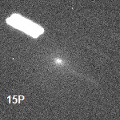
|
It brightened very rapidly. Now it is very bright as 10.7 mag (July 20, Osamu Miyazaki). It stays 10 mag until August. It stays observable in the morning sky for a long time.
Date(TT) R.A. (2000) Decl. Delta r Elong. m1 Best Time(A, h)
July 31 4 56.49 23 37.3 1.258 1.024 52 9.9 3:30 (259, 27)
Aug. 7 5 24.55 24 56.8 1.299 1.054 52 9.9 3:38 (258, 29)
|
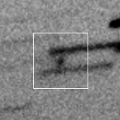
|
Now it is 12.2 mag (July 27, Ken-ichi Kadota). Brightening very rapidly. It will brighten up to 8.5 mag from September to October. But the condition is bad in this apparition. In the Northern Hemisphere, it is observable only in the extremely low sky until July. In the Southern Hemisphere, it will be observable after late August. But it stays locating low for a while.
Date(TT) R.A. (2000) Decl. Delta r Elong. m1 Best Time(A, h)
July 31 7 12.09 25 14.5 1.989 1.110 21 10.7 3:30 (240, 2)
Aug. 7 7 35.25 20 50.0 1.941 1.074 22 10.3 3:38 (245, 1)
|

|
Now it is very bright as 10.4 mag (July 27, Chris Wyatt). It stays observable at 10 mag in good condition for a long time from spring to summer.
Date(TT) R.A. (2000) Decl. Delta r Elong. m1 Best Time(A, h)
July 31 14 25.43 -3 22.3 1.847 2.068 87 10.3 20:41 ( 55, 34)
Aug. 7 14 35.73 -6 16.2 1.921 2.080 84 10.5 20:32 ( 55, 31)
|

|
Now it is 11.6 mag (July 20, Osamu Miyazaki). It will brighten up to 10 mag from summer to autumn, and it will be observable in excellent condition.
Date(TT) R.A. (2000) Decl. Delta r Elong. m1 Best Time(A, h)
July 31 3 20.80 17 53.4 1.608 1.669 75 11.2 3:30 (278, 43)
Aug. 7 3 40.57 18 26.0 1.548 1.653 77 11.0 3:38 (280, 47)
|

|
Now it is very bright as 11.2 mag (July 12, Chris Wyatt). It stays bright as 10-12 mag until August. In the Southern Hemisphere, it stays observable in excellent condition for a long time. In the Northern Hemisphere, it becomes extremely low after this.
Date(TT) R.A. (2000) Decl. Delta r Elong. m1 Best Time(A, h)
July 31 0 6.70 -46 39.1 0.589 1.462 129 11.8 3:30 ( 0, 9)
Aug. 7 0 7.22 -48 49.7 0.629 1.506 131 12.0 3:06 ( 0, 6)
|

|
Now it is 11.7 mag (July 18, Thomas Lehmann). It will brighten up to 10 mag in winter in 2022. In the Northern Hemisphere, it stays observable in good condition for a long time. In the Southern Hemisphere, it is not observable until November.
Date(TT) R.A. (2000) Decl. Delta r Elong. m1 Best Time(A, h)
July 31 6 8.21 47 44.6 4.533 3.848 42 12.0 3:30 (228, 25)
Aug. 7 6 19.74 47 18.0 4.456 3.825 46 11.9 3:38 (230, 28)
|
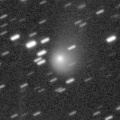
|
Now it is 13.5 mag (July 27, Chris Wyatt). It is expected to be observable at 5-6 mag for a long time from 2022 to 2023. In the Northern Hemisphere, it is not observable at the high light from 2022 summer to 2023 summer. In the Southern Hemisphere, it stays extremely low for a while. But it will be observable in good condition at the high light.
Date(TT) R.A. (2000) Decl. Delta r Elong. m1 Best Time(A, h)
July 31 17 9.34 38 45.4 5.393 5.732 104 12.2 20:41 (155, 86)
Aug. 7 17 5.36 37 32.6 5.382 5.673 101 12.2 20:32 (113, 83)
|

|
Now it is 14.2 mag (July 18, Toshihiko Ikemura, Hirohisa Sato). It will brighten up to 9 mag, and will be observable in good condition in winter.
Date(TT) R.A. (2000) Decl. Delta r Elong. m1 Best Time(A, h)
July 31 1 34.36 5 1.8 1.084 1.655 103 13.8 3:30 (320, 54)
Aug. 7 1 51.48 6 40.5 0.991 1.603 106 13.4 3:38 (326, 57)
|
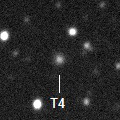
|
Now it is 14.6 mag (July 12, Chris Wyatt). It is expected to brighten up to 11.5 mag in 2022. In the Southern Hemisphere, it stas observable in good condition for a long time, although it becomes extremely low temporarily from August to September. In the Northern Hemisphere, it is not observable until November.
Date(TT) R.A. (2000) Decl. Delta r Elong. m1 Best Time(A, h)
July 31 9 32.87 -22 15.7 5.662 4.962 42 13.8 20:41 ( 85,-33)
Aug. 7 9 40.67 -22 15.0 5.672 4.933 39 13.7 20:32 ( 86,-36)
|
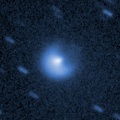
|
Now it is faint as 16.1 mag (July 22, J. Drummond).
Date(TT) R.A. (2000) Decl. Delta r Elong. m1 Best Time(A, h)
July 31 4 34.59 30 9.5 6.397 5.900 56 13.8 3:30 (254, 34)
Aug. 7 4 39.05 30 23.5 6.305 5.902 62 13.8 3:38 (257, 40)
|
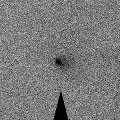
|
It brightened up to 10.1 mag in spring (Apr. 10, Marco Goiato). Now it is fading. It has already faded down to 13.6 mag (July 16, Ken-ichi Kadota). It stays observable in good condition for a long time after this while the comet will fading.
Date(TT) R.A. (2000) Decl. Delta r Elong. m1 Best Time(A, h)
July 31 3 57.18 8 49.2 2.022 1.912 69 13.8 3:30 (282, 31)
Aug. 7 4 8.41 8 58.6 1.994 1.955 72 13.9 3:38 (286, 36)
|

|
Now it is 13.6 mag (July 16, Ken-ichi Kadota). It stays 13-14 mag from 2020 to 2021. It will be observable in good condition after this in the Southern Hemisphere. It locates somewhat low in the Northern Hemisphere.
Date(TT) R.A. (2000) Decl. Delta r Elong. m1 Best Time(A, h)
July 31 18 50.07 -35 6.4 2.063 2.987 150 13.9 22:13 ( 0, 20)
Aug. 7 18 46.69 -35 21.7 2.122 2.998 143 14.0 21:42 ( 0, 20)
|
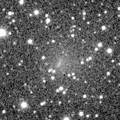
|
Now it is 13.9 mag (July 17, Thomas Lehmann). It will brighten very rapidly, and it will be observable at 10 mag in good condition from October to December. In the Northern Hemisphere, it locates somewhat low at the high light.
Date(TT) R.A. (2000) Decl. Delta r Elong. m1 Best Time(A, h)
July 31 16 16.75 3 13.4 0.747 1.465 111 14.5 20:41 ( 27, 55)
Aug. 7 16 23.88 -0 23.1 0.748 1.437 108 13.9 20:32 ( 29, 51)
|

|
Now it is bright as 13.4 mag (July 12, Chris Wyatt). It stays 13 mag until early summer. In the Southern Hemisphere, it stays observable in good condition for a long time. It locates somewhat low in the Northern Hemisphere.
Date(TT) R.A. (2000) Decl. Delta r Elong. m1 Best Time(A, h)
July 31 13 41.88 -7 36.4 3.547 3.492 78 14.1 20:41 ( 61, 24)
Aug. 7 13 41.06 -6 43.8 3.699 3.511 71 14.2 20:32 ( 65, 21)
|
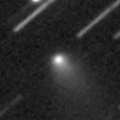
|
Now it is 14.5 mag (July 25, R. Naves, M. Campas). It will brighten up to 14 mag in summer, and it will be observable in excellent condition. It locates somewhat low in the Southern Hemisphere.
Date(TT) R.A. (2000) Decl. Delta r Elong. m1 Best Time(A, h)
July 31 18 21.48 32 36.1 1.714 2.380 119 14.2 21:42 ( 0, 88)
Aug. 7 17 52.06 31 53.6 1.777 2.361 112 14.2 20:46 ( 0, 87)
|
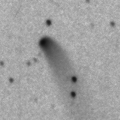
|
Now it is 14.3 mag (July 21, Ken-ichi Kadota). It stays 14-15 mag until the end of 2021. In the Southern Hemisphere, it stays observable in good condition for a long time. It locates low in the Northern Hemisphere.
Date(TT) R.A. (2000) Decl. Delta r Elong. m1 Best Time(A, h)
July 31 23 30.51 -34 2.6 3.638 4.455 139 14.6 2:57 ( 0, 21)
Aug. 7 23 25.32 -33 54.5 3.604 4.469 144 14.6 2:24 ( 0, 21)
|
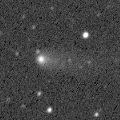
|
Now it is 14.8 mag (July 12, Chris Wyatt). It was expected to brighten up to 13 mag from spring to summer. But actually, it is fainter than originally expected. It stays 14-15 mag until early autumn. In the Southern Hemisphere, it stays observable in good condition for a long time. In the Northern Hemisphere, it is not observable until July in 2022.
Date(TT) R.A. (2000) Decl. Delta r Elong. m1 Best Time(A, h)
July 31 23 53.02 -87 32.4 3.137 3.612 109 14.7 3:21 ( 0,-32)
Aug. 7 23 7.03 -87 44.2 3.168 3.619 108 14.7 2:11 ( 0,-33)
|

|
Now it is 15.0 mag (July 5, Chris Wyatt). It stays at 14-15 mag for a long time from 2021 to 2022. It stays observable in good condition after this while brightening gradually.
Date(TT) R.A. (2000) Decl. Delta r Elong. m1 Best Time(A, h)
July 31 16 36.75 -9 43.7 4.455 5.046 120 14.8 20:41 ( 14, 44)
Aug. 7 16 32.12 -10 45.7 4.553 5.039 113 14.8 20:32 ( 21, 42)
|

|
Now it is 15.6 mag (July 16, Ken-ichi Kadota). It stays 15 mag from summer to autumn. In the Southern Hemisphere, it stays observable for a long time. In the Northern Hemisphere, it will be getting higher gradually after this, and it will be observable in good condition after summer.
Date(TT) R.A. (2000) Decl. Delta r Elong. m1 Best Time(A, h)
July 31 4 23.12 16 5.7 1.749 1.542 61 15.3 3:30 (271, 30)
Aug. 7 4 43.18 18 2.0 1.704 1.534 62 15.3 3:38 (271, 34)
|

|
It will brighten up to 14.5 mag from spring to summer. In the Southern Hemisphere, it stays observable in excellent condition for a long time. In the Northern Hemisphere, it is not observable after this.
Date(TT) R.A. (2000) Decl. Delta r Elong. m1 Best Time(A, h)
July 31 9 15.68 -60 35.8 2.854 2.846 79 15.3 20:41 ( 37,-45)
Aug. 7 9 37.47 -58 55.7 2.951 2.873 75 15.4 20:32 ( 39,-44)
|
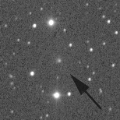
|
It brightened up to 14.2 mag in early summer (June 10, Thomas Lehmann). Now it is not observable. It will be fading after this. In the Northern Hemisphere, it will appear in the morning sky at 16 mag in October. In the Southern Hemisphere, it will never be observable again.
Date(TT) R.A. (2000) Decl. Delta r Elong. m1 Best Time(A, h)
July 31 9 56.78 15 18.2 2.913 1.977 18 15.3 20:41 (114, -7)
Aug. 7 10 10.64 16 29.5 2.949 1.987 15 15.3 20:32 (116, -7)
|
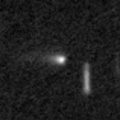
|
Now it is 16.1 mag (July 16, Ken-ichi Kadota). It will approach to Earth down to 0.2 a.u. in December, and it is expected to brighten up to 4 mag. In the Northern Hemisphere, it stays observable in good condition for a long time until December while the comet is brightening gradually. In the Southern Hemisphere, it is not observable until mid December.
Date(TT) R.A. (2000) Decl. Delta r Elong. m1 Best Time(A, h)
July 31 10 35.12 46 17.4 3.457 2.710 36 15.5 20:41 (134, 18)
Aug. 7 10 38.54 45 9.0 3.392 2.619 34 15.3 20:32 (135, 15)
|
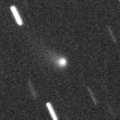
|
Now it is 15.4 mag (July 17, Thomas Lehmann). In the Northern Hemisphere, it stays observable at 15-16 mag for a long time from spring to early 2022. In the Southern Hemisphere, it is not observable until the end of 2021.
Date(TT) R.A. (2000) Decl. Delta r Elong. m1 Best Time(A, h)
July 31 12 23.50 51 4.3 3.484 3.011 54 15.4 20:41 (131, 36)
Aug. 7 12 25.41 48 7.9 3.538 3.007 51 15.4 20:32 (129, 33)
|

|
Now it is 15.8 mag (July 10, Thomas Lehmann). It will brighten up to 13 mag in 2022. In 2021, it is observable at 14-15 mag in good condition.
Date(TT) R.A. (2000) Decl. Delta r Elong. m1 Best Time(A, h)
July 31 13 20.29 -5 4.7 3.609 3.447 72 15.5 20:41 ( 67, 21)
Aug. 7 13 25.94 -5 53.4 3.687 3.433 67 15.5 20:32 ( 68, 18)
|
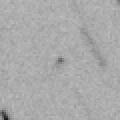
|
Now it is 17.4 mag (July 20, ATLAS-MLO, Mauna Loa). It will brighten rapidly up to 9 mag in winter. It will be observable in good condition.
Date(TT) R.A. (2000) Decl. Delta r Elong. m1 Best Time(A, h)
July 31 0 15.23 -47 2.6 1.611 2.374 127 15.9 3:30 (358, 8)
Aug. 7 0 17.70 -49 1.6 1.539 2.322 129 15.6 3:16 ( 0, 6)
|

|
It brightened up to 11.6 mag in winter (Feb. 18, Thomas Lehmann). Now it is fading. It has already faded down to 15.2 mag (June 22, Thomas Lehmann). In the Southern Hemisphere, it stays observable in good condition after this. In the Northern Hemisphere, it will never be observable after this.
Date(TT) R.A. (2000) Decl. Delta r Elong. m1 Best Time(A, h)
July 31 5 32.21 -56 39.3 3.323 3.383 84 15.6 3:30 (323,-24)
Aug. 7 5 32.96 -57 55.5 3.359 3.449 86 15.7 3:38 (327,-21)
|

|
Now it is 15.8 mag (July 8, ATLAS-MLO, Mauna Loa). It stays observable at 15-16 mag in good condition until autumn.
Date(TT) R.A. (2000) Decl. Delta r Elong. m1 Best Time(A, h)
July 31 16 31.40 -14 40.2 4.274 4.867 120 15.7 20:41 ( 14, 39)
Aug. 7 16 30.21 -13 49.3 4.373 4.865 113 15.7 20:32 ( 21, 39)
|

|
Now it is 15.7 mag (June 9, Toshihiko Ikemura, Hirohisa Sato). It is expected to brighten up to 13 mag in 2022. In the Southern Hemisphere, it stays observable in good condition for a long time. In the Northern Hemisphere, it is not observable for a while.
Date(TT) R.A. (2000) Decl. Delta r Elong. m1 Best Time(A, h)
July 31 12 0.58 -21 54.0 4.712 4.352 63 15.8 20:41 ( 66, -4)
Aug. 7 12 1.55 -22 24.5 4.765 4.309 57 15.7 20:32 ( 68, -8)
|
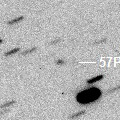
|
Now it is 16.7 mag (July 17, Ken-ichi Kadota). It will brighten up to 15.5 mag from summer to autumn. It stays observable for a long time.
Date(TT) R.A. (2000) Decl. Delta r Elong. m1 Best Time(A, h)
July 31 15 24.25 -14 37.8 1.327 1.864 104 15.9 20:41 ( 33, 34)
Aug. 7 15 32.86 -15 16.4 1.367 1.841 100 15.8 20:32 ( 35, 32)
|
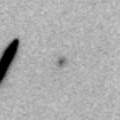
|
Now it is 15.5 mag (July 27, Ken-ichi Kadota). It will brighten rapidly up to 15 mag in autumn. It will be observable in excellent condition in the Northern Hemisphere. It locates somewhat low in the Southern Hemisphere.
Date(TT) R.A. (2000) Decl. Delta r Elong. m1 Best Time(A, h)
July 31 3 41.67 14 6.9 1.737 1.709 71 16.0 3:30 (279, 37)
Aug. 7 3 59.46 15 36.4 1.675 1.694 73 15.8 3:38 (280, 42)
|
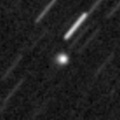
|
Now it is 16.4 mag (July 17, Thomas Lehmann). It is expected to brighten up to 11 mag in 2023. In the Northern Hemisphere, it stays observable in good condition for a long time. It locates extremely low in the Southern Hemisphere.
Date(TT) R.A. (2000) Decl. Delta r Elong. m1 Best Time(A, h)
July 31 16 28.43 47 23.6 6.158 6.301 93 15.9 20:41 (147, 75)
Aug. 7 16 22.59 46 22.8 6.167 6.256 90 15.9 20:32 (134, 72)
|
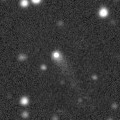
|
Now it is 16.2 mag (June 25, ATLAS-HKO, Haleakala). It stays observable at 16 mag from 2021 to 2022.
Date(TT) R.A. (2000) Decl. Delta r Elong. m1 Best Time(A, h)
July 31 13 43.83 1 26.1 4.869 4.729 76 16.1 20:41 ( 68, 30)
Aug. 7 13 46.71 1 50.1 4.971 4.723 70 16.1 20:32 ( 71, 27)
|
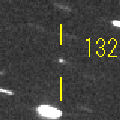
|
Now it is 17.9 mag (July 18, Toshihiko Ikemura, Hirohisa Sato). It will brighten very rapidly up to 14 mag, and it will be observable in excellent condition in autumn.
Date(TT) R.A. (2000) Decl. Delta r Elong. m1 Best Time(A, h)
July 31 0 4.26 3 12.0 1.205 1.975 125 16.5 3:30 ( 0, 58)
Aug. 7 0 10.26 3 30.1 1.122 1.942 130 16.2 3:09 ( 0, 59)
|

|
Now it is 16.7 mag (July 22, Thomas Lehmann). It will brighten up to 12.5 mag in 2022 summer. In the Southern Hemisphere, it stays observable in excellent condition for a long time. In the Northern Hemisphere, it is not observable until August in 2022.
Date(TT) R.A. (2000) Decl. Delta r Elong. m1 Best Time(A, h)
July 31 3 58.68 -52 56.7 4.727 4.894 93 16.3 3:30 (328,-11)
Aug. 7 4 0.67 -54 50.0 4.633 4.846 96 16.2 3:38 (333, -9)
|

|
Now it is 16.0 mag (July 20, Thomas Lehmann). In the Northern Hemisphere, it stays observable for a long time while it is getting fainter slowly. In the Southern Hemisphere, it will never be observable again.
Date(TT) R.A. (2000) Decl. Delta r Elong. m1 Best Time(A, h)
July 31 13 32.06 53 50.8 6.763 6.405 65 16.2 20:41 (134, 47)
Aug. 7 13 34.02 52 33.5 6.853 6.453 62 16.3 20:32 (132, 44)
|
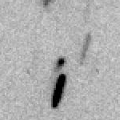
|
Now it is 16.3 mag (July 14, J.-G. Bosch, F. Kugel). It stays observable at 16 mag in good condition until autumn.
Date(TT) R.A. (2000) Decl. Delta r Elong. m1 Best Time(A, h)
July 31 23 23.16 -6 48.7 1.453 2.316 138 16.3 2:49 ( 0, 48)
Aug. 7 23 23.72 -7 41.2 1.401 2.310 145 16.2 2:22 ( 0, 47)
|

|
Now it is 16.5 mag (July 7, ATLAS-MLO, Mauna Loa). It is observable at 16 mag from 2020 to 2021. It locates low in the Southern Hemisphere.
Date(TT) R.A. (2000) Decl. Delta r Elong. m1 Best Time(A, h)
July 31 22 46.33 44 44.0 5.606 6.040 110 16.3 2:13 (180, 80)
Aug. 7 22 39.35 44 16.0 5.539 6.049 115 16.3 1:38 (180, 81)
|

|
Announced as a bright Centaur-type asteroid. But Hidetaka Sato revealed that this is Phoebe, one of the satellites of Saturn.
Date(TT) R.A. (2000) Decl. Delta r Elong. m1 Best Time(A, h)
July 31 20 52.63 -18 21.7 8.858 9.872 177 16.4 0:20 ( 0, 37)
Aug. 7 20 50.66 -18 30.4 8.862 9.874 175 16.4 23:46 ( 0, 37)
|

|
Now it is 16.2 mag (June 29, ATLAS-MLO, Mauna Loa). It stays at 16-17 mag from 2020 to 2021. In the Northern Hemisphere, it stays observable in good condition for a long time. It locates extremely low in the Southern Hemisphere.
Date(TT) R.A. (2000) Decl. Delta r Elong. m1 Best Time(A, h)
July 31 18 48.00 51 43.5 8.530 8.859 105 16.4 22:10 (180, 73)
Aug. 7 18 42.77 51 40.1 8.548 8.863 104 16.4 21:37 (180, 73)
|

|
Now it is 18.1 mag (June 29, Thomas Lehmann). It will be observable at 11 mag from winter to spring in 2022. In 2021, it is observable until July or August when it brightens up to 16-17 mag.
Date(TT) R.A. (2000) Decl. Delta r Elong. m1 Best Time(A, h)
July 31 11 30.00 6 58.5 3.258 2.605 42 16.6 20:41 ( 94, 7)
Aug. 7 11 39.66 5 54.4 3.275 2.563 38 16.5 20:32 ( 94, 4)
|
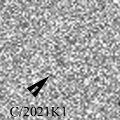
|
Now it is 16.2 mag (July 9, ATLAS-MLO, Mauna Loa). It stays 16.5 mag until August and stays observable in good condition.
Date(TT) R.A. (2000) Decl. Delta r Elong. m1 Best Time(A, h)
July 31 1 5.71 -5 5.9 2.055 2.638 114 16.5 3:30 (337, 48)
Aug. 7 1 10.04 -5 45.9 2.007 2.660 119 16.5 3:38 (349, 49)
|

|
Now it is 16.5 mag (July 18, Thomas Lehmann). Fading slowly. In the Northern Hemisphere, it stays observable in good condition for a long time. It is not observable after this in the Southern Hemisphere.
Date(TT) R.A. (2000) Decl. Delta r Elong. m1 Best Time(A, h)
July 31 16 42.93 56 30.3 5.438 5.537 90 16.5 20:41 (167, 68)
Aug. 7 16 34.96 55 48.7 5.510 5.568 88 16.6 20:32 (158, 67)
|

|
It brightened up to 3 mag in December in the SOHO spacecraft images (Dec. 18, Hirohisa Sato). Now it is 17.2 mag (July 10, ATLAS-MLO, Mauna Loa). It stays observable in good condition after this while the comet will be fading.
Date(TT) R.A. (2000) Decl. Delta r Elong. m1 Best Time(A, h)
July 31 0 13.25 20 10.3 3.221 3.767 115 16.5 3:30 (352, 75)
Aug. 7 0 8.99 20 4.6 3.209 3.849 122 16.6 3:08 ( 0, 75)
|
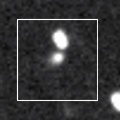
|
Now it is 16.7 mag (July 20, Thomas Lehmann). It is expected to brighten up to 10 mag in 2023. In the Northern Hemisphere, it stays observable in good condition until 2023 autumn. In the Southern Hemipshere, it stays extremely low until July, then it becomes unobservable for a while. But it becomes observable in good condition after 2023 summer.
Date(TT) R.A. (2000) Decl. Delta r Elong. m1 Best Time(A, h)
July 31 12 3.49 36 0.0 7.343 6.704 47 16.6 20:41 (116, 28)
Aug. 7 12 5.23 35 38.2 7.346 6.651 43 16.6 20:32 (117, 25)
|
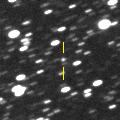
|
Now it is 17.0 mag (July 18, Thomas Lehmann). It is expected to brighten up to 11 mag from spring to summer in 2022. In the Southen Hemisphere, it locates somewhat low in 2021, but it will be observable in good condition at the high light for a long time. In the Northern Hemisphere, it is observable in good condition in 2021, but it will not be observable at the high light.
Date(TT) R.A. (2000) Decl. Delta r Elong. m1 Best Time(A, h)
July 31 19 40.85 35 20.7 3.406 4.067 124 16.8 23:03 (180, 90)
Aug. 7 19 30.15 33 54.7 3.341 4.004 124 16.6 22:24 ( 0, 89)
|

|
Now it is 16.8 mag (July 18, Toshihiko Ikemura, Hirohisa Sato). It is expected to brighten up to 11 mag in 2023. In the Northern Hemisphere, it is observable in good condition in 2021. But it is observable only until November in 2022. In the Southern Hemisphere, it locates extremely low in 2021. But it will be observable in good condition at the high light.
Date(TT) R.A. (2000) Decl. Delta r Elong. m1 Best Time(A, h)
July 31 17 39.79 42 24.1 6.179 6.538 106 16.7 21:02 (180, 83)
Aug. 7 17 35.74 41 18.8 6.165 6.490 104 16.7 20:32 (179, 84)
|
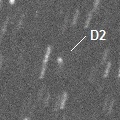
|
Now it is 17.6 mag (July 9, ATLAS-HKO, Haleakala). It will brighten up to 15.5 mag in winter. In the Northern Hemisphere, it stays observable in good condition for a long time. It is not observable at all in the Southern Hemisphere.
Date(TT) R.A. (2000) Decl. Delta r Elong. m1 Best Time(A, h)
July 31 18 17.45 74 23.2 3.430 3.482 84 16.8 21:36 (180, 51)
Aug. 7 17 41.98 74 18.5 3.410 3.447 83 16.7 20:34 (180, 51)
|
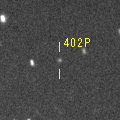
|
First return of a new periodic comet observed at 16 mag from 2003 to 2004. Now it is 16.8 mag (Apr. 11, J. Drummond). It will brighten up to 16 mag in winter, and it will be observable in excellent condition. It will be getting higher gradually.
Date(TT) R.A. (2000) Decl. Delta r Elong. m1 Best Time(A, h)
July 31 5 39.88 2 23.4 4.637 4.015 47 16.9 3:30 (272, 6)
Aug. 7 5 47.26 2 25.9 4.564 4.007 51 16.8 3:38 (276, 12)
|
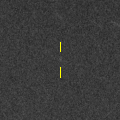
|
Now it is 17.2 mag (July 17, ATLAS-MLO, Mauna Loa). It will brighten up to 16.5 mag in autumn and it will be observable in good condition.
Date(TT) R.A. (2000) Decl. Delta r Elong. m1 Best Time(A, h)
July 31 23 37.39 -2 48.2 1.344 2.176 134 17.1 3:04 ( 0, 52)
Aug. 7 23 36.67 -2 2.0 1.291 2.172 140 16.9 2:35 ( 0, 53)
|

|
It had been observed as 8-9 mag for a long time in 2020. Now it is fading. It has already faded down to 16.8 mag (July 9, Thomas Lehmann). It will be observable in good condition after this in the Southern Hemisphere. It locates extremely low after this in the Northern Hemisphere.
Date(TT) R.A. (2000) Decl. Delta r Elong. m1 Best Time(A, h)
July 31 16 9.27 -45 57.3 4.770 5.328 118 16.9 20:41 ( 12, 8)
Aug. 7 16 7.86 -45 46.1 4.924 5.389 112 17.1 20:32 ( 15, 7)
|

|
First return of a new periodic comet observed at 17 mag in 2014. It has not been observed yet in this apparition. It is expected to brighten up to 17 mag from summer to autumn, and it will be observable in good condition.
Date(TT) R.A. (2000) Decl. Delta r Elong. m1 Best Time(A, h)
July 31 1 58.65 22 8.1 1.349 1.722 92 17.0 3:30 (290, 62)
Aug. 7 2 10.02 23 51.8 1.311 1.738 95 17.0 3:38 (293, 68)
|

|
Appearing in the morning sky. It will brightens rapidly. And it will be observable at 15 mag in excellent condition in winter.
Date(TT) R.A. (2000) Decl. Delta r Elong. m1 Best Time(A, h)
July 31 5 49.71 28 44.0 3.191 2.504 40 17.2 3:30 (248, 19)
Aug. 7 6 3.92 28 34.6 3.127 2.496 43 17.0 3:38 (250, 23)
|

|
Now it is 16.5 mag (July 8, ATLAS-MLO, Mauna Loa). It will be fading after this, and it will be fainter than 18 mag in October.
Date(TT) R.A. (2000) Decl. Delta r Elong. m1 Best Time(A, h)
July 31 15 19.72 -21 0.3 4.735 5.097 105 17.1 20:41 ( 31, 27)
Aug. 7 15 15.96 -21 23.1 4.883 5.120 97 17.2 20:32 ( 36, 24)
|

|
Now it is 16.5 mag (July 19, Katsumi Yoshimoto). In the Northern Hemisphere, it stays observable in good condition while the comet will be fading. In the Southern Hemipsphere, it stays locating extremely low after this. Thomas Lehmann reported it was bright as 15.4 mag on July 18.
Date(TT) R.A. (2000) Decl. Delta r Elong. m1 Best Time(A, h)
July 31 4 20.61 38 3.0 2.764 2.410 59 17.1 3:30 (247, 39)
Aug. 7 4 33.78 39 0.9 2.720 2.436 63 17.2 3:38 (247, 44)
|

|
Now it is 16.7 mag (July 18, Toshihiko Ikemura, Hirohisa Sato). In the Northern Hemisphere, it stays observable in good condition after this while the comet will be fading. In the Southern Hemisphere, it stays locating extremely low for a long time.
Date(TT) R.A. (2000) Decl. Delta r Elong. m1 Best Time(A, h)
July 31 4 18.31 32 15.3 2.591 2.261 59 17.1 3:30 (254, 38)
Aug. 7 4 29.96 33 15.5 2.571 2.314 64 17.2 3:38 (255, 43)
|
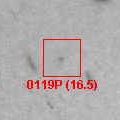
|
Now it is 18.9 mag (July 12, W. Hasubick). It will brighten up to 14.5 mag in 2022 winter. In 2021, it stays observable in good condition while the comet will be brightening gradually. It is fainter than this ephemeris recently.
Date(TT) R.A. (2000) Decl. Delta r Elong. m1 Best Time(A, h)
July 31 23 5.68 -13 53.8 2.445 3.327 144 17.3 2:32 ( 0, 41)
Aug. 7 23 3.09 -14 29.9 2.371 3.301 152 17.2 2:02 ( 0, 41)
|

|
Appearing in the morning sky. Now it is 18.4 mag (July 10, Palomar Mountain--ZTF). In the Northern Hemisphere, it stays observable at 17 mag in good condition until winter. In the Southern Hemisphere, it stays locating extremely low for a while.
Date(TT) R.A. (2000) Decl. Delta r Elong. m1 Best Time(A, h)
July 31 5 29.33 38 1.4 2.481 1.918 45 17.2 3:30 (241, 27)
Aug. 7 5 50.55 38 0.5 2.444 1.921 48 17.2 3:38 (242, 29)
|
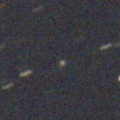
|
Now it is 17.6 mag (July 9, Michael Jager). It stays observable at 17-18 mag for a long time until 2024.
Date(TT) R.A. (2000) Decl. Delta r Elong. m1 Best Time(A, h)
July 31 14 20.89 -5 26.1 9.043 9.048 87 17.4 20:41 ( 55, 32)
Aug. 7 14 19.89 -5 22.3 9.156 9.039 80 17.4 20:32 ( 59, 29)
|
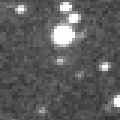
|
Now it is 16.9 mag (July 19, ATLAS-HKO, Haleakala)�$B!#�(BIt stays observable at 17-18 mag for a long time from 2021 to 2022.
Date(TT) R.A. (2000) Decl. Delta r Elong. m1 Best Time(A, h)
July 31 19 12.85 -18 22.6 3.178 4.143 159 17.4 22:36 ( 0, 37)
Aug. 7 19 9.86 -18 29.4 3.214 4.136 151 17.4 22:05 ( 0, 37)
|

|
First return of a new periodic comet which brightened up to 17 mag in 2012. Now it is 18.4 mag (July 7, L. S. Amaral). In the Southern Hemisphere, it is observable at 17.5 mag in excellent condition in summer. It locates low in the Northern Hemisphere.
Date(TT) R.A. (2000) Decl. Delta r Elong. m1 Best Time(A, h)
July 31 19 47.01 -40 10.1 0.774 1.748 155 17.5 23:10 ( 0, 15)
Aug. 7 19 40.80 -40 55.4 0.748 1.701 149 17.4 22:36 ( 0, 14)
|
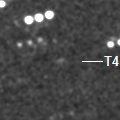
|
Now it is extremely faint as 20.5 mag (June 17, M. Jaeger, E. Prosperi, S. Prosperi). It was predicted to brighten up to 17.5 mag in 2021 summer. But actually, it is much fainter than predicted. It is not observable in the Southern Hemisphere.
Date(TT) R.A. (2000) Decl. Delta r Elong. m1 Best Time(A, h)
July 31 12 4.34 71 3.8 2.527 2.212 60 17.5 20:41 (156, 37)
Aug. 7 12 39.60 66 51.4 2.536 2.225 60 17.5 20:32 (151, 38)
|

|
Now it is 16.8 mag (June 10, Toshihiko Ikemura, Hirohisa Sato). It will be fading slowly.
Date(TT) R.A. (2000) Decl. Delta r Elong. m1 Best Time(A, h)
July 31 17 6.06 -11 27.4 7.218 7.882 127 17.5 20:41 ( 4, 43)
Aug. 7 17 2.61 -11 16.9 7.345 7.908 120 17.5 20:32 ( 11, 43)
|
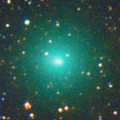
|
It brightened up to 8.2 mag in 2020 autumn (Oct. 13, 2020, Chris Wyatt). Now it is 18.9 mag (July 15, Palomar Mountain--ZTF). It is observable at 18 mag in 2021.
Date(TT) R.A. (2000) Decl. Delta r Elong. m1 Best Time(A, h)
July 31 4 38.64 22 0.5 3.473 3.034 56 17.5 3:30 (263, 30)
Aug. 7 4 45.99 22 18.4 3.425 3.073 61 17.6 3:38 (266, 35)
|
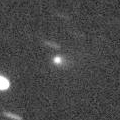
|
First return of a new periodic comet which brightened up to 16 mag in 2014. Now it is 16.9 mag (July 5, Thomas Lehmann). It stays observable at 16-17 mag in good condition until July.
Date(TT) R.A. (2000) Decl. Delta r Elong. m1 Best Time(A, h)
July 31 13 15.76 -10 55.8 2.188 2.141 73 17.7 20:41 ( 63, 17)
Aug. 7 13 26.79 -12 39.1 2.260 2.144 70 17.7 20:32 ( 63, 14)
|
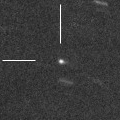
|
Now it is 17.9 mag (July 18, Toshihiko Ikemura, Hirohisa Sato). It is observable at 17 mag in good condition in autumn.
Date(TT) R.A. (2000) Decl. Delta r Elong. m1 Best Time(A, h)
July 31 2 17.00 18 26.0 3.736 3.865 89 17.7 3:30 (291, 56)
Aug. 7 2 21.21 18 38.8 3.631 3.859 95 17.7 3:38 (299, 62)
|

|
First return of a new periodic comet which brightened up to 17 mag in 2006. Now it is 17.4 mag (June 15, Taras Prystavski). It stays 18 mag from 2021 to 2022.
Date(TT) R.A. (2000) Decl. Delta r Elong. m1 Best Time(A, h)
July 31 22 38.30 -69 5.8 2.610 3.311 126 17.8 2:05 ( 0,-14)
Aug. 7 22 29.69 -69 31.9 2.601 3.295 125 17.8 1:29 ( 0,-14)
|

|
Now it is 17.6 mag (July 5, W. Hasubick). It will brighten up to 16 mag in 2022. In 2021, it stays observable at 18 mag until September.
Date(TT) R.A. (2000) Decl. Delta r Elong. m1 Best Time(A, h)
July 31 13 41.90 -2 41.3 3.295 3.222 76 17.8 20:41 ( 65, 27)
Aug. 7 13 47.91 -3 38.1 3.376 3.212 72 17.8 20:32 ( 66, 24)
|

|
It brightened up to 18.5 mag in 2020 spring (Apr. 2, 2020, W. Hasubick). Now it is 19.3 mag (July 16, J. P. Desgrees, J. L. Virlichie, P. Traverse, H. Roy). It has passed the perihelion in 2020 October. At the discovery in 2005, it stayed bright for several years even after the perihelion passage. In this apparition, it may stay observable at 18 mag from 2021 to 2024.
Date(TT) R.A. (2000) Decl. Delta r Elong. m1 Best Time(A, h)
July 31 23 51.02 -24 49.9 3.027 3.818 135 17.8 3:17 ( 0, 30)
Aug. 7 23 49.81 -25 36.2 2.994 3.837 141 17.8 2:49 ( 0, 30)
|

|
It has not been observed yet in this apparition. It will brightens rapidly. And it is expected to be observable at 10-11 mag in good condition from December to February.
Date(TT) R.A. (2000) Decl. Delta r Elong. m1 Best Time(A, h)
July 31 22 49.89 1 32.0 1.303 2.197 142 18.2 2:16 ( 0, 57)
Aug. 7 22 47.17 1 32.9 1.202 2.139 149 17.8 1:46 ( 0, 57)
|

|
It brightened up to 13.8 mag in autumn in 2019 (Sept. 3, 2019, Chris Wyatt). Now it is fading slowly. It stays 18 mag until autumn.
Date(TT) R.A. (2000) Decl. Delta r Elong. m1 Best Time(A, h)
July 31 0 48.32 21 2.4 7.840 8.206 107 17.9 3:30 (322, 73)
Aug. 7 0 46.87 21 22.1 7.780 8.249 114 17.9 3:38 (353, 76)
|
|
![]()
 C/2019 O3 ( Palomar )
C/2019 O3 ( Palomar ) 22P/Kopff
22P/Kopff C/2021 K1 ( ATLAS )
C/2021 K1 ( ATLAS ) C/2019 K7 ( Smith )
C/2019 K7 ( Smith ) C/2020 S3 ( Erasmus )
C/2020 S3 ( Erasmus ) C/2020 V2 ( ZTF )
C/2020 V2 ( ZTF ) C/2021 E3 ( ZTF )
C/2021 E3 ( ZTF ) C/2020 K1 ( PanSTARRS )
C/2020 K1 ( PanSTARRS ) C/2021 D2 ( ZTF )
C/2021 D2 ( ZTF ) 402P/2020 Q3 ( LINEAR )
402P/2020 Q3 ( LINEAR ) 193P/LINEAR-NEAT
193P/LINEAR-NEAT C/2017 T2 ( PanSTARRS )
C/2017 T2 ( PanSTARRS ) P/2014 W12 ( Gibbs )
P/2014 W12 ( Gibbs ) 110P/Hartley 3
110P/Hartley 3 C/2017 Y2 ( PanSTARRS )
C/2017 Y2 ( PanSTARRS ) 17P/Holmes
17P/Holmes 28P/Neujmin 1
28P/Neujmin 1 119P/Parker-Hartley
119P/Parker-Hartley 241P/LINEAR
241P/LINEAR C/2020 F2 ( ATLAS )
C/2020 F2 ( ATLAS ) 395P/2020 H1 ( Catalina-NEAT )
395P/2020 H1 ( Catalina-NEAT ) P/2021 L5 ( La Sagra )
P/2021 L5 ( La Sagra ) C/2020 T4 ( PanSTARRS )
C/2020 T4 ( PanSTARRS ) C/2017 U7 ( PanSTARRS )
C/2017 U7 ( PanSTARRS ) 88P/Howell
88P/Howell 413P/2020 W4 ( Larson )
413P/2020 W4 ( Larson ) P/2021 N2 ( Fuls )
P/2021 N2 ( Fuls ) P/2021 L1 ( Christensen )
P/2021 L1 ( Christensen ) 152P/Helin-Lawrence
152P/Helin-Lawrence 378P/2019 E2 ( McNaught )
378P/2019 E2 ( McNaught ) 104P/Kowal 2
104P/Kowal 2 C/2017 B3 ( LINEAR )
C/2017 B3 ( LINEAR )![]()































































